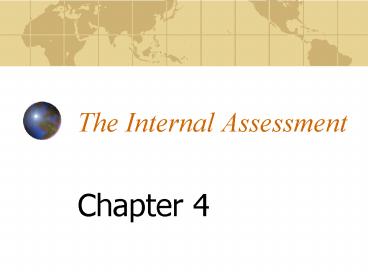The Internal Assessment PowerPoint PPT Presentation
1 / 34
Title: The Internal Assessment
1
The Internal Assessment
- Chapter 4
2
Internal Assessment
- Like a product or service, the planning process
itself must be managed and shaped, if it is to
serve executives as a vehicle for strategic
decision-making - Robert Lenz
3
Internal Strategic Management Audit
- Functional areas of the business
- Strengths
- Weaknesses
- Focuses on developing objectives and strategies
to capitalize on internal strengths and overcome
weaknesses
4
Distinctive Competencies
- A firms strengths that cannot be easily matched
or imitated by competitors - Building competitive advantage involves taking
advantage of distinctive competencies - Strategies designed in part to improve on a
firms weaknesses and turn to strengths
5
Internal AuditGather assimilate information
from
- Management
- Marketing
- Finance/accounting
- Production/operations
- Research development
- Management information systems
6
- Involvement in performing an internal
- strategic-management audit provides
- vehicle for understanding nature and
- effect of decisions in other functional
- business areas of the firm
7
Management
- Planning
- Organizing
- Motivating
- Staffing
- Controlling
8
Stage of Strategic- Management Process When Most
Important
Function
Planning
Strategy Formulation
Organizing
Strategy Implementation
Motivating
Strategy Implementation
Staffing
Strategy Implementation
Controlling
Strategy Evaluation
9
Management Audit Checklist
- Does the firm use strategic-management concepts?
- Are company objectives and goals measurable and
well communicated? - Do managers at all hierarchical levels plan
effectively? - Do managers delegate authority well?
- Is the organizations structure appropriate?
10
- Are job descriptions and job specifications
clear? - Is employee morale high?
- Are employee turnover and absenteeism low?
- Are organizational reward and control mechanisms
effective?
11
Marketing
- Customer analysis
- Selling products/services
- Product and service planning
- Pricing
- Distribution
- Marketing research
- Opportunity analysis
12
Marketing Audit Checklist
- Are markets segmented effectively?
- Is the organization positioned well among
competitors? - Has the firms market share been increasing?
- Are present channels of distribution reliable and
cost effective? - Does the firm have an effective sales force?
13
- Does the firm conduct market research?
- Are product quality and customer service good?
- Are the firm's products/services priced
appropriately? - Does the firm have an effective promotion,
advertising, and publicity strategy?
14
- Are marketing planning and budgeting effective?
- Do the firms marketing mangers have adequate
experience and training?
15
Finance/Accounting
- Investment decision (Capital budgeting)
- Financing decision
- Dividend decision
16
Finance/Accounting Audit Checklist
- Where is the firm strong and weak as indicated by
financial ratio analysis? - Can the firm raise needed short-term capital?
- Can the firm raise needed long-term capital
through debt and/or equity? - Does the firm have sufficient working capital?
- Are capital budgeting procedures effective?
17
- Are dividend payout policies reasonable?
- Does the firm have good relations with its
investors and stockholders? - Are the firms financial managers experienced and
well trained?
18
Production/Operations
- Process
- Capacity
- Inventory
- Workforce
- Quality
19
Production/Operations Audit Checklist
- Are suppliers of raw materials, parts, and
subassemblies reliable and reasonable? - Are facilities, equipment, machinery, and offices
in good condition? - Are inventory-control policies and procedures
effective?
20
- Are quality-control policies and procedures
effective? - Are facilities, resources, and markets
strategically located? - Does the firm have technological competencies?
21
Research Development
- Development of new products before competition
- Improving product quality
- Improving manufacturing processes to reduce costs
22
Research Development Audit Checklist
- Does the firm have RD facilities? Are they
adequate? - If outside RD firms are used, are they cost
effective? - Are the organizations RD personnel well
qualified? - Are RD resources allocated effectively?
23
- Are management information and computer systems
adequate? - Is communication between RD and other
organizational units effective? - Are present products technologically competitive?
24
Computer Information Systems
- Information Systems
- CIO/CTO
- Security
- User-friendly
- E-commerce
25
Computer Information Systems Audit Checklist
- Do all managers in the firm use the information
system to make decisions? - Is there a chief information officer or director
of information systems position in the firm? - Are data in the information system updated
regularly?
26
- Do managers from all functional areas of the firm
contribute input to the information system? - Are there effective passwords for entry into the
firms information system? - Are strategists of the firm familiar with the
information systems of rival firms?
27
- Is the information system user-friendly?
- Do all users of the information system understand
the competitive advantages that information can
provide firms? - Are computer training workshops provided for
users? - Is the firms system being improved?
28
Competitive Analysis Porters Five-Forces Model
Potential development of substitute products
Rivalry among competing firms
Bargaining power of suppliers
Bargaining power of consumers
Potential entry of new competitors
29
Internal Analysis (IFE)
- Five-Step Process
- List key internal factors (10-20)
- Strengths weaknesses
- Assign weight to each (0 to 1.0)
- Sum of all weights 1.0
30
- Assign 1-4 rating to each factor
- Firms current strategies response to the factor
- Multiply each factors weight by its rating
- Produces a weighted score
31
- Sum the weighted scores for each
- Determines the total weighted score for the
organization - Highest possible weighted score for the
organization is 4.0 the lowest, 1.0. Average
2.5
32
(No Transcript)
33
(No Transcript)
34
- Circus Circus (in the previous example), has a
total weighted score of 2.75 indicating that the
firm is above average in its overall internal
strength

